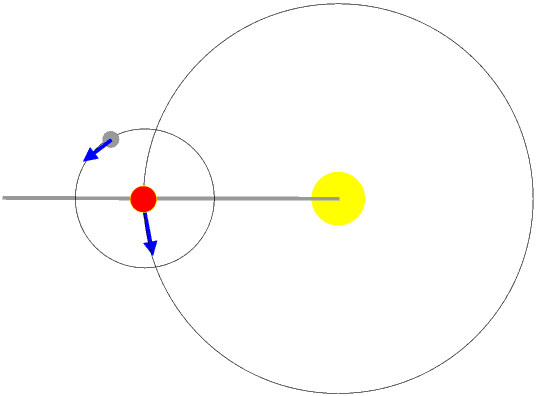
If we could look down on the Solar System from a point a long way above the North Pole we would see the Sun in the middle, with the Earth and all the other planets going round it, the Moon going round the Earth and all the moons of all the other planets going round them, and the Sun, Earth, Moon and all the other planets and all their moons rotating on their axes. This is the way we usually draw the Solar System. In drawings made like this almost everything in the Solar System is moving or rotating anti-clockwise.
Here is a drawing of the orbits of just the Earth and Moon (not to scale of course; we cannot draw a picture of the Solar System to scale, and this is explained in the Page on The Size of the Solar System).

This drawing shows a line passing through the Sun and The Earth. We get a New Moon when the Moon crosses this line on the Sun side of the Earth and a Full Moon when it crosses it on the other side. The Moon goes round the Earth about once every twenty eight days but because the Earth is also moving round the Sun the position of the line between the Earth and Sun is also moving, so we actually get a new Moon about every 29½ days, and of course a Full Moon about 14½ days later. This is more fully explained in the Page on the Moon.
If we look at the orbits of the Earth and Moon edge on rather than from on top this is what we shall see.

If we have a point source of light the light will travel outwards from it in every direction. If we put an object in the way of the light it will cast a shadow. The dark area behind the object is called the umbra (from the Latin for shadow). The umbra, and therefore the shadow, has a sharp edge because you can see either all of the light or none of it - “Now you see me now you don’t.”
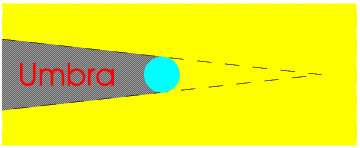
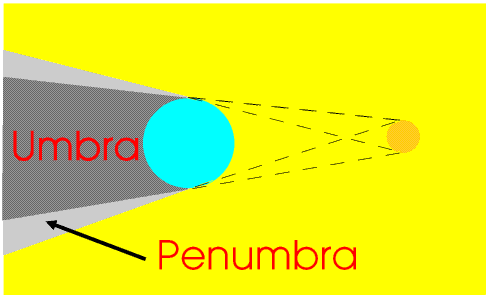
Here the object casting the shadow is bigger than the light source, but of course the Sun is a lot bigger than the Earth and the other planets and their moons.
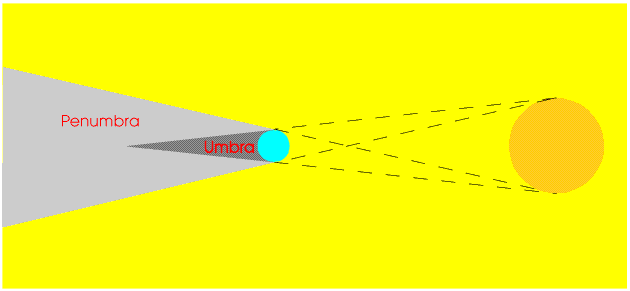
The diameter of the Sun is almost exactly 400 times greater than the diameter of the Moon but it is also almost exactly 400 times further from the Earth. This means that to someone on the surface of the Earth the Sun and Moon appear to be almost exactly the same size. Many people find this hard to believe because when the Sun is setting it looks much bigger than the Moon when it is high in the sky, but you can prove it for yourself quite easily.
Choose a time when you can see the Moon fairly high in the sky - any shape Moon will do it, it does not have to be Full. Take a small piece of Plasticene or other modelling clay and make a little ball. Hold this ball at arm’s length and then adjust its size until its diameter is the height of the Moon. Keep it safely until a time when you can see the Full Moon rising and then hold it at arm’s length again. It should just cover the Moon. You can also try it during the day if you can see the Sun as a yellow disc through a thick cloud - but never try this during the day when the Sun is not behind a thick cloud - the Sun is far too bright and you may damage your eyes.
You can also do it if you are at the seaside or in the countryside and you can see the Sun setting on the horizon, but only if the Sun is actually touching the horizon and appears red and you can see it as a disc. If you cannot see the edge of the Sun it is too bright and you will hurt your eyes.The Sun “looks” bigger at Sunset because when we are looking at the Sun and the Earth at the same time our brain cannot work out that the Sun is much further away and so plays a trick on us - an optical illusion. Here is a video of an old Persil advertisement which illustrates this.
This is the best example of how size and distance can play tricks on the way we see things that I have ever come across - thank you Persil! You do get some other stuff afterwards but I think this is a small price to play and you do not have to watch it.
What all of this means is that at the time of a total eclipse the tip of the Moon’s umbra just touches the surface of the Earth.

Inside the umbra there is a total eclipse, but inside the penumbra only a partial eclipse. The total eclipse can be seen in an area about 250 km across and a partial eclipse in an area about 3000 km across. Because the Earth is rotating on its axis and the Moon is moving round the Earth and the Earth is moving round the Sun these areas are also moving very fast (more than 1680 kilometres an hour, depending upon where you are on the Earth’s surface), and in any one place the total part of the eclipse lasts only a few minutes.
You can see some spectacular animations of solar eclipses by visiting this Eclipse Web Site Once it is loaded go to Eclipses On Line and then enter a year. Try 1999 for the last total eclipse visible from the British Isles; the next one is not until 2090! There is also lots of other information about eclipses on this web site and it is well worth while bookmarking it and exploring it. There are lots of other Eclipse Web Sites, some very good and some very bad.
Up to now we have considered that the Earth and the other planets go round the Sun in circular orbits, but this is not true, they actually go round the Sun in ellipses, with the Sun at one focus, not in the middle.
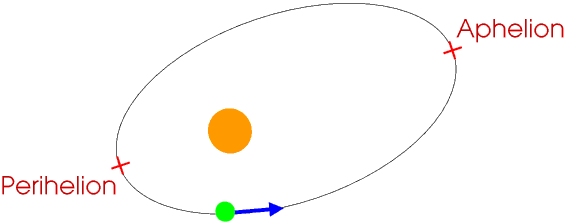
What this means is that the distance between the Earth and Sun is not constant. The Earth is at perihelion (from the Greek for nearest to the Sun) when it is closest to the Sun, and at aphelion when it is furthest.
Similarly, the orbit of the Moon round the Earth is also an ellipse, with a perigee (from the Greek for nearest to the Earth) and an apogee . So if an eclipse of the Sun occurs when the Earth is at its nearest to the Sun and the Moon is at its furthest from the Earth the Moon’s umbra does not quite reach the surface of the Earth and so the Moon appears very slightly smaller than the Sun and does not quite cover it. This is an annular eclipse, from the Latin for a ring, when we can see a ring of sunlight all round the Moon. Sometimes an eclipse starts as total but ends as annular, or visa versa, and astronomers call this a hybrid eclipse.

To an astronomer a total eclipse of the Sun is one where the umbra touches the surface of the Earth. Total eclipses are very important to astronomers because they allow them to study the Sun’s corona.
The Sun is shooting plumes of gas millions of kilometres into space but these cannot usually be seen from the Earth because the Sun’s surface is far too bright. But during a total eclipse the surface of the Sun is covered by the Moon and these plumes of gases can be seen, like a crown (corona) surrounding the Sun. You can see some stunning pictures of the corona, and other photos of the 1999 total eclipse, by going to Mr Eclipse’s Web Site.You can of course only see the total eclipse from a very tiny part of the Earth’s surface and very few people will see it, so the astronomers studying the corona must be prepared to go anywhere. Many more people will be in the penumbra and see a partial eclipse. But astronomers reserve the term partial eclipse for one where the umbra passes just over the North Pole or just under the South Pole so part of the Earth’s surface is in the penumbra but none of it is in the umbra.
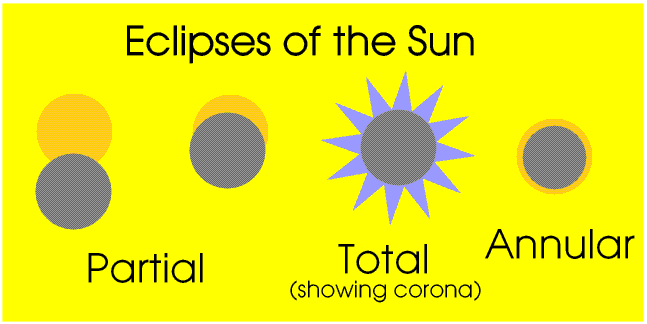
To astronomers a hybrid eclipse is one which is visible as a total eclipse in one place and annular in another.

There must be at least two solar eclipses a year but there can be up to five. Most of these are partial but there is usually a total or annular eclipse somewhere on the Earth about every eighteen months. Hybrid eclipses are very much less common. However a total (or annular) eclipse can be seen from only a very tiny part of the Earth’s surface, and so very few people will see more than one during their lifetime. The last total eclipse visible from Southern England was in 1999, the next will be in 2090. You can find out more about past and future eclipses from NASA’s Eclipse Web Page. There are also many other sites giving information about future eclipses, but some of these are quite technical and many of them are just trying to sell you something. There is more about predicting eclipses in the last Section of this Page.

It is very dangerous to look directly at the Sun, at the time of a solar eclipse or at any other time.
You can talk about and read about watching a eclipse of the Sun as much as you like and whenever you like, but the only time information about watching one is of the slightest importance to you is when there is one near you. So this Page tells you not what to do now, but what to do then.
When there is a solar eclipse visible in your area most of the local observatories and astronomical societies will hold Open Days, almost always free, when they use their telescopes to project the Sun's image onto a giant screen for you to look at. This is by far the best way of watching it, as there will be experts explaining it and answering your questions. Look for details in your local newspapers and on your local tv.
You can also make a pin-hole camera from an old shoe box to project the image of the Sun onto a piece of white card. You can find instructions on several web sites.
You can also buy special eclipse goggles: these will be on sale in local shops for several weeks before the day, and can be bought on the internet at any time. But do not buy a pair until just before you need them, and throw them away afterwards - to keep the cost down they are made of inexpensive materials and are only intended to be used once, not last a long time.
These three are the only safe ways of observing a total eclipse, and do not let anyone tell you otherwise.
Before the invention of the telescope, in 1608, astronomers had watched eclipses in a camera obscura, Latin for a darkened room, in which an image of the Sun formed by a pinhole in a screen was focused onto a white wall. The image was much bigger than that produced by the pinhole camera described above but not very bright, which is why you had to be in a darkened room to see it properly. You could form an image of almost anything this way, and the camera obscura was the forerunner of photography - hence our word camera.

An eclipse of the Moon (a lunar eclipse) occurs when the Moon passes through the Earth’s shadow. This can only happen when the Moon is on the ecliptic at the time of a Full Moon. (This is more fully explained in the Section on solar eclipses, above.)

A total eclipse does of course go through all three stages in turn. Most astronomers are not very interested in penumbral eclipses and most people do not notice them unless they know that they are happening. If you find a web site or book giving the dates of lunar eclipses penumbral eclipses are not usually included.
Total eclipses of the Moon are much less common than total eclipses of the Sun, but they last for up to ninety minutes and are visible from about half the Earth, so most people will see several during their lifetime. The last one visible in Southern England was in September 2015 and the next one will be on January 31st 2018.
The Moon does not go totally dark because the Earth’s atmosphere is scattering and refracting (bending) the light from the Sun and so some light enters the umbra. Because the blue light is scattered more than the red the Moon appears reddish brown. The actual colour and brightness depends upon the amount of water vapour and dust in the atmosphere: in August 1883 Krakatoa, a volcano in Indonesia, erupted very violently and the dust from it produced some really spectacular lunar eclipses, also lots of wonderful sunsets and very cold summers for several years.
In the Bible and many other old writings there are references to “The Moon being turned to blood”, which is not a bad description of a total eclipse of the Moon.
You can see pictures of some lunar eclipses on the NASA Eclipse Web Page. There is a lot more about lunar eclipses, and how one saved Christopher Columbus, on the Starry Skies web site. This site is well worth bookmarking for lots of other wonderful information about the night sky.

Today if there is to be a total eclipse of the Sun visible near where you live, there will be lots about it on tv and in the newspapers for weeks before it happens, and all the shops will be full of “eclipse goggles”. If by some chance you have not heard about it, if you are indoors and you notice it getting cold and dark you will probably just put the lights on and turn up the heat a little; if you are out of doors when it happens you might say “What’s happening?” and someone will be bound to reply “It’s an eclipse of the Sun, didn’t you know?” If there is a total eclipse of the Moon most people who live in towns are unlikely to notice it, and even if they do they will probably not give it a second thought. But it has not always been like that.
Until about two hundred and fifty years ago, and the start of the Industrial Revolution, most people, everywhere in the World, lived in villages and worked the land for food. These people may not have understood the finer points of photosynthesis but they did know that it was the warmth of the Sun which made the plants grow. So anything which affected the Sun was for them a matter of life and death. If one day in the middle of the day without any warning the Sun suddenly started getting darker, unless they knew what was happening they would be terrified - and who could blame them? Or who could blame them for being terrified if the Full Moon turned to blood?
Words ending in -ology come from Greek words which mean “the study of” - geology is the study of the Earth, psychology the study of the mind, zoology the study of animals, etc. Astrology was originally just the study of the stars, what is today called astronomy.
It is not difficult to predict eclipses of the Sun and Moon, but you do need to make accurate measurements of the apparent movement of the Sun and Moon (that is, the way they appear to move to people living on the Earth) for a period of at least twenty years. More than four thousand years ago the ancient Chinese, Indian, Persian, Arabic and Egyptian astrologers were keeping stunningly accurate observations of the Sun and Moon, and also the Planets, for hundreds of years at a time and were able to predict eclipses of the Sun and Moon for several years ahead - many of these records still exist today! There were of course no telescopes until after 1600 CE, so these astrologers used sighting tubes, astrolobes and other instruments instead. But these instruments were very big and expensive and very few people had the skills needed to use them or the mathematical knowledge needed to do the calculations. More to the point, at a time when almost all the population were necessarily peasants working on the land to grow food, very few people could afford the time or the money to study the stars. So astrologers were usually rich and powerful people, rulers such as Princes, Kings and Emperors, or people in their service.In those days there was no street lighting, in fact no lighting at all except oil lamps and candles, so there was no light pollution and everyone could see the glories of the Night Sky, all night and every night. The motions of the Sun and Moon and Planets across the sky were as well known and important to people then as the characters in soap operas such as Coronation Street and East Enders are to people today.
Man has known for thousands of years that the movements of the Sun and Moon across the sky influence the tides, and the spawning of fish, and the behaviour of nocturnal animals such as wolves, and many other things, and if you are watching the movements of the Sun and Moon and Planets every night it is not a big step from using their movements to predict the tides, and animal behaviour, and other things, to believing that they might also influence the lives of men. Today many people might say that the people who believed this were mistaken but I do not think we can say that they were foolish. So Princes and Kings and Emperors had astrologers to help them predict and interpret these movements, and of course predicting and interpreting eclipses was particularly important to them.
During the 8th, 9th and 10th centuries CE the leaders of the Islamic world encouraged the scientific study of the sky (astronomy) and there were enormous advances in it, but astrology as a means of foretelling the future was considered to be contrary to the Qur’an and the two began to be separated. Today the separation is complete.
In every age there has never been any shortage either of simple and gullible people or of dishonest people willing to take advantage of them. Once astrologers (astronomers) began to be able to predict eclipses, inevitably there would be some who would take advantage of this knowledge for their own purposes, for example “Unless you give me lots of money, at half past nine tonight I will turn the Moon to blood.” By about the 10th century CE the Islamic astronomers were publishing almanacs giving details of eclipses and much other information about the movements of the Sun, Moon and Planets, and obtaining money from people in this way became more difficult.Almanacs were very important to sailors and people in the desert trying to navigate by the Sun and Moon and stars, which is of course the main reason why they were produced. Christopher Columbus took one to the Americas with him, and this saved his life: you can read about it on the Starry Skies web site.
Today astrology is once again Big Business. I have a lot of respect for the people living three thousand years ago who could actually watch Mars entering Taurus, and think it might affect their lives, but none whatever for people living today who have never bothered to look at the Night Sky, and could not tell Taurus from Orion or Mars from Betelgeuse even if they did, but are still willing to pay people to tell them what will happen to them when Mars is in Taurus.

Venus and Mercury are planets orbiting the Sun, like the Earth, but they are nearer to the Sun than the Earth and so must at some stage cross a line between the Sun and the Earth. This Paragraph is mainly about Venus, but Mercury behaves in a similar way.

The Earth goes round the Sun in about 365 days whereas Venus, being closer to the Sun, goes round it in about 222 days. (Mercury, being closer still, goes round the Sun in about 88 days.) So Venus crosses the line between the Earth and the Sun about every 583 days. However the orbit of Venus is at an angle of about 3 degrees to the eclipic so it does not pass directly between the Earth and the Sun every time it crosses the line between them, but only when it is on the ecliptic.

A transit of Venus occurs when Venus passes directly between the Earth and the Sun. Venus is about the same size as the Earth but is much further away than the Moon so appears very much smaller and does not come any way near to covering the Sun. You cannot of course see the transit directly because the Sun is far too bright, but you can see it quite clearly, as a black dot moving across the Sun’s disc, if you project the Sun onto a screen, as for an eclipse of the Sun.
Unlike eclipses of the Sun and Moon, the early astronomers had no way of predicting transits of Mercury or Venus with a sufficient degree of accuracy - that had to wait until after Kepler had published his First Law of Planetary Motion, which said that the planets went round the Sun not in circles but in ellipses. The Islamic astronomer al-Fabari may have observed the transit of Venus in 910 CE, but no more were observed until after the invention of the telescope in 1608 and the publication of Kepler’s First and Second Laws in 1609.
Transits of Venus are very uncommon: the pattern is two eight years apart and then not another one for more than a hundred and five years. There was a transit of Venus in 2004 and then again in 2012, but the next one will be in 2117.
Transits of Venus were very important to seventeenth century astronomers because they offered, for the first time, a way of measuring the size of Venus and its distance from the Sun, and a much more accurate measurement of the distance of the Sun from the Earth.
The telescope was invented in 1608, and Kepler’s First and Second Laws were published in 1609. Kepler had predicted the transit of Venus in 1631, but this occurred during the night in Europe and was not observed. The first transit to be observed through a telescope (by projecting it onto a white card of course) was in 1639, by the English astromomer Nicholas Horrocks (1618 - 1641). He was only 21 at the time, and died less than two years later, but he is now regarded as the father of English astronomy. The next transits were in 1761 and 1769, and astronomers from all over Europe were very excited about these. At that time ships on long sea voyages navigated using the Sun and Moon and stars, and for this they needed accurate astronomical tables. It was believed that if astronomers observed the transit of Venus from several different places and compared the results they would be able to produce more accurate tables. Sadly it was cloudy almost everywhere in Europe in 1761 and so no observations were made. But for the 1769 transit Captain James Cook was sent to the South Pacific to set up an observatory on the island of Tahiti. You can read about this on the James Cook and the Transit of Venus web site.
Transits of Mercury are much more common, with one every seven to ten years, but Mercury is very much closer to the Sun than Venus, and so moves more quickly, and it is very much smaller. Mercury is so tiny and moves so quickly that its transits are not very interesting to watch and most astronomers do not bother with them.
